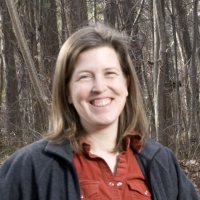Faculty Perspectives: Emily Bernhardt
Emily S. Bernhardt, Jerry G. and Patricia Crawford Hubbard Professor of Biology and Professor of Environmental Sciences and Policy
Bass Connections Project Team: Environmental Epidemiology in Latin America: Impacts of Artisanal Gold Mining in the Peruvian Amazon
In the Peruvian Amazon, humans’ gold-mining activities are resulting in mercury pollution and deforestation. Bernhardt is leading a Bass Connections project team to study the impacts of this mining; other faculty members include Bill Pan, Ernesto Ortiz and John Terborgh, joined by an interdisciplinary team of graduate and undergraduate students.
Below are excerpts from her remarks for the Duke Interdisciplinary Studies website.
Engaging a Diverse Team of Students
Our Bass [Connections] team is really an amazing collection of people. Jackie Gerson [Ph.D. student in Ecology] is an incredibly capable lead and she did a great job recruiting and selecting students.
We have three global health/environmental health-focused undergraduate students. Two [Kelsey Lansdale and Eliza Letourneau] are seniors and both are conducting their honors thesis on component research projects within this study. Our sophomore student Melissa Marchese is conducting an independent study and already thinking about how to return for a second trip and use the data collected for her senior thesis.
These three great undergrads are complemented by three really impressive professional students. Tatiana Manidis is a MEM student who is interested in the human exposure part of this study. Chris Lara is a Public Policy master’s student from Colombia with 15 years of experience working at the UN on behalf of South American environmental policy issues. Natalia Rivadeneyra heard about our group and asked to join us. We were thrilled because Natalia is a practicing environmental lawyer in Peru who is at Duke earning her law LLM degree. She has started an environmental nonprofit in Peru and is assisting us with a comparative analysis of the legal and policy frameworks governing (or failing to govern) this illegal and highly polluting form of gold mining.
We are providing a truly unique and interdisciplinary educational experience for seven students from five degree programs, and I can honestly say I am learning a ton from all seven of them.
I am also realizing that my role is to facilitate. I am good at helping set agendas and priorities for groups and that is the one skillset this group collectively lacks. They are individually impressive and quite collaborative but need help pointing their considerable energies into a single direction.
A New Research Effort
This [Bass Connections project] has introduced an entirely new research effort for my lab group, allowing us to apply our tools in biogeochemistry and ecosystem science to a new problem of the Anthropocene.
I hope we will follow the same trajectory as our work on mountaintop removal coal mining, in which a small amount of seed money led to a decade of work and a major foundation and NSF grant as well as real impact on the science and policy arena surrounding this important environmental issue.
Data to Guide Policy Decisions
I am engaging in a wholly new set of important questions about how Hg [mercury] is being added to and cycling through the Peruvian Amazon. This would not have been possible without Bass Connections’ support. I think we are already generating vitally important information to guide management and policy—we are providing the first ever measures of soil and water methyl mercury (the bioavailable form) in Peru—and we are poised to provide far more.
Data collected from this summer’s field work is accumulating. We expect to generate several high-profile papers and to have sufficient information to go after a much larger grant to continue and expand upon this research on Hg pollution associated with artisanal gold mining in one of the world’s biodiversity hotspots—Peru’s Madre de Dios river.
See other faculty perspectives and learn how you can get involved in Bass Connections.

